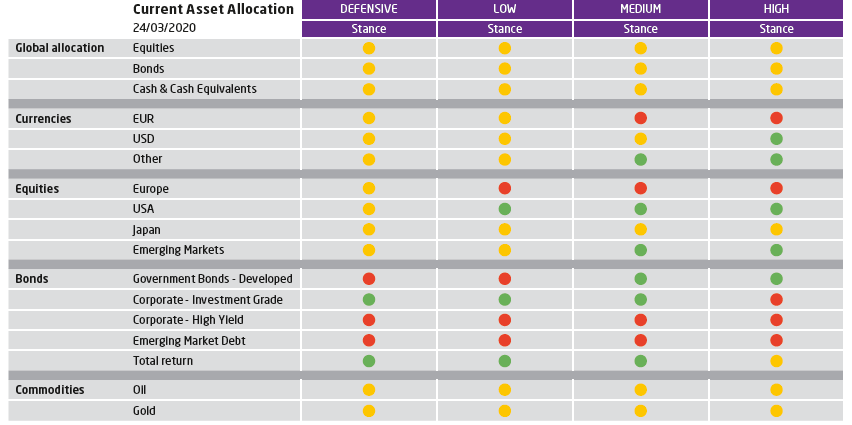Choose Language
April 1, 2020
BilboardBILBoard March 2020: Patience, discipline and opportunistic portfolio rebalancing
The global economy is in an induced coma and the coronavirus
pandemic will lead to a profound, but not permanent, reduction in economic activity.
2.5 billion people (one-third of the global population) now have some kind of
restriction on their movement as governments attempt to snuff out the virus. The
consequent fall in demand, halted production and severe supply chain disruptions
undoubtedly mean that the global economy is now in recession.
The length of the recession will depend on the course of the
pandemic (epidemiological factors such as when new infections will peak are an
unknown) as well as the policy response. There is no playbook for what’s going
to happen next; nor do we have any comparable historical episodes. However,
China now seems to be approaching the light at the end of the tunnel, and with
the virus having peaked, the cogs of its economy are gradually starting to turn
again.



Our base case scenario sees a government-led ‘Great
Cessation’ spanning Q2, with both supply and demand hitting the rocks. This
could be devastating for the millions of small businesses that form the
backbone of the global economy. A wave of layoffs, missed rental payments and
bankruptcies are likely to follow, even if governments move quickly to bridge the
disruption. But the economic system has a natural adaptive ability: it will
survive. Q2’s deep recession will not result in some kind of economic ice age: once
social distancing is no longer required, the economy will gradually come back
to life. Consumer spending will resume, delayed purchases will be made. Robust
companies will further extend their leadership, while new needs, ideas and
opportunities will erupt.
But in the meantime, markets are struggling to think that
far ahead, with media-induced fear and anxiety steering sentiment. The result
has been a precipitous stock market drop, faster than any other in history.
To calm capital markets and prevent a prolonged recession
and self-fulfilling feedback loop, regulators, governments and central banks are
on the frontline, with some resorting to war-time measures. Monetary
authorities are promising as much liquidity as financial intermediaries and
credit markets want, and the heaviest artillery lines are being reinforced by
massive public and fiscal spending. At the same time, financial institutions
are in a much more robust position than they were in the past, with smaller
balance sheets and high capital buffers, allowing them to offer credit lines to
temporarily cash-strapped companies.
Theoretically, the S&P 500’s valuation has recalibrated
to more attractive levels. The reason we say “theoretically” is because no one
has any idea what earnings will actually be. But eventually, anxiety will
decline and consumption, spending, investment and production will return. Markets will have already rebounded before the recovery shows up
in the macro data. With this in mind, we decided to top up our equity
exposure to rectify the ‘portfolio drift’ effect (the
decline in the market value of stocks naturally meant that they accounted for a
smaller portion of our portfolio than they did before the sell-off), and bring
our overall equity exposure back to neutral. We did so by cherry-picking high-quality names, using fundamental screening
to identify well-poised, high-cash,
low-debt companies generating high levels of free cash flow,
while avoiding sectors/activities at acute risk of disruption in the current
context.
We have also rejigged our sovereign
bond exposure. While the overall allocation to this asset class was held
steady, we increased our euro-hedged US Treasury holdings towards 20% of the
total government bond exposure by selling a proportionate amount of European
government bonds. The primary reason for this is to diversify interest curve
risk: if the situation deteriorates, Treasuries have more room to move
downwards in terms of yield than European equivalents. The best thing to do in
the fixed income world at the moment is to stay safe. Credit spreads have blown
out across all credit tiers; even those on AAA-rated investment grade paper more
than doubled in just ten days, and, if 2008 levels are anything to go by,
spreads could still widen significantly. High yield is basically a no go for
the time being and the new issue market is closed. The segment, in both the US
and Europe, is threatened by a wave of fallen angels (the downgrade of IG bonds
to the junk category), while the US high yield space looks even more febrile
when you consider its close correlation with the oil price (due to the presence
of many shale-producing firms). For now, Saudi Arabia’s price war persists, which
last week caused crude to dip below $25 per barrel.
With so many moving parts, it is true
that things may get worse before they get better. However, we should stay
focused on long-term investment objectives, reassured that with so much fiscal
and monetary firepower being brought to the table, this is not the beginning of
the end. The majority of blue chip companies and household names will survive
this.
For now, the best thing we can do is play our part in “flattening the curve” and getting this disease under wraps by staying at home if possible, while implementing social distancing and near-obsessional hygiene. If in need of something to watch and/or reassurance, the new Netflix series “Night on Earth” is a solid pick. Using the latest camera technology, it lifts night's veil to reveal the hidden lives of the world's creatures after dark. A reassuring anecdote comes from the arctic frog. These tiny amphibians are captured surviving almost completely frozen, to the point where they stop breathing and their hearts stop beating entirely for weeks at a time. But when warmer weather comes, the frogs are shown miraculously defrosting and coming back to life – let’s think of the economy like an arctic frog.



Change: Indicates the change in our exposure since the previous month’s asset allocation committee
More
July 18, 2024
BilboardBILBoard August 2024 – Stocks get tha...
Based on the Committee of 15th July 2024 Over the past few weeks, two important developments have played out for investors. Firstly, US inflation...
July 16, 2024
NewsTourism, a fragile pillar of Europe&#...
Accounting for around 10% of the EU's GDP, tourism is one of the key pillars of the European economy, with a considerable impact on...
July 1, 2024
NewsCan US households continue driving gr...
Consumers are the Atlas holding up the American economy. With the US representing around one-quarter of global output, and with personal consumption accounting for an...
June 21, 2024
BilboardBILBoard – Summer 2024
Despite tight monetary conditions, the global economy held up remarkably well throughout the first half of 2024. From this point on, it appears to be...

